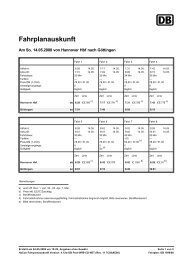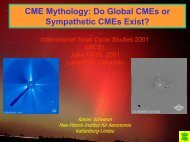The Instrument - the SOHO home page
The Instrument - the SOHO home page
The Instrument - the SOHO home page
Create successful ePaper yourself
Turn your PDF publications into a flip-book with our unique Google optimized e-Paper software.
Contents<br />
Objectives<br />
• Morphology of <strong>the</strong> Emission Line Corona<br />
• Triggering and Initial Evolution of Dynamical Events<br />
What do we need?<br />
• Coronagraphy<br />
- lens vs mirror coronagraphs<br />
- internally vs externally occulted<br />
What is MICA?<br />
• MICA as an internally occulted mirror coronagraph<br />
- <strong>Instrument</strong> Layout<br />
- Technical specifications Filters background<br />
Camera background<br />
How does MICA work?<br />
• Observation technique<br />
• Auxiliary Devices<br />
Narrow band imagery
12:34 UT 12:52 UT 12:56 UT<br />
Apr 20, 1999 - Seq.<br />
13:01 UT 13:04 UT 13:10 UT<br />
13:13 UT 13:19 UT 13:22 UT
Set 30, 1998 - Seq<br />
13:16 UT 13:17 UT 13:20 UT 13:22 UT 13:23 UT<br />
13:25 UT 13:28 UT 13:29 UT 13:31 UT 13:32 UT<br />
13:33 UT 13:37 UT 13:40 UT 13:41 UT 13:44 UT
<strong>The</strong> K-corona K<br />
(kontinuerliches(<br />
Spektrum)<br />
• White light from <strong>the</strong> photosphere scattered on free electrons in <strong>the</strong> partly ionized corona<br />
• Absence of Fraunhofer absorption lines (high electron temperature: Doppler-smear-out)<br />
• Intensity proportional to electron density (summed up along line of sight)<br />
• Strongly polarized, parallel to solar limb<br />
<strong>The</strong> F-coronaF<br />
<strong>The</strong> solar corona: : Four different components<br />
• White light from <strong>the</strong> photosphere, scattered on dust particles<br />
• Continuum spectrum like in <strong>the</strong> photospeheric one, including Fraunhofer lines<br />
• Very low degree of polarization<br />
• Also known as Zodiacal light<br />
Components Solar Corona I<br />
<strong>The</strong> T-corona T<br />
(<strong>the</strong>rmal corona)<br />
• <strong>The</strong>rmal radiation of heated dust particles<br />
• Continuous infrared spectrum, according to temperature of dust particles<br />
• Barely visible<br />
……...
<strong>The</strong> E-corona E<br />
(emission line corona)<br />
• Line emission from various atoms and ions in <strong>the</strong> corona<br />
• Strongest line in visible spectral range: 530.3 nm of FeXIV ions (green line)<br />
• Many lines in UV and EUV spectral ranges, e.g., FeXII (19.5 nm), FeXV (28.4 nm)<br />
• Strong radial gradients<br />
• Many forbidden lines, <strong>the</strong>refore various polarization states<br />
<strong>The</strong> high ionization state of emitting species reveals<br />
<strong>the</strong> high temperature of <strong>the</strong> emission corona.<br />
Components Solar Corona II<br />
Knowledge of <strong>the</strong> observational characteristics of <strong>the</strong> different corona components<br />
Understanding of <strong>the</strong> physical mechanisms responsible of <strong>the</strong> emission<br />
Separation of <strong>the</strong> components<br />
Polarizers<br />
Isolation of <strong>the</strong> K-corona.<br />
Isolation emission lines<br />
Narrow band filters<br />
+<br />
Background subtraction techniques
Relative Intensity<br />
E: Emission Line Corona<br />
F: Fraunhofer Corona<br />
K: Continuum (“white light”) Corona.<br />
Relative intensity of <strong>the</strong> coronal light components and <strong>the</strong> sky as<br />
function of solar distance (in solar radii). <strong>The</strong> relative intensity is<br />
normalized to <strong>the</strong> intensity at <strong>the</strong> center of <strong>the</strong> solar disk.<br />
After van der Hulst, 1953.
Lyot refractive internally occulted coronagraph<br />
Lyot<br />
Coronagraph<br />
LF<br />
R<br />
Oc<br />
LS<br />
O2<br />
FP<br />
A1 O1<br />
FL<br />
A1: entrance aperture<br />
O1: objective lens<br />
Oc: internal occulter,<br />
FL: field lens<br />
LS: Lyotstop<br />
LF: Lyot spot<br />
O2: transfer lens<br />
FP: focal plane.<br />
<strong>The</strong> solid lines show <strong>the</strong> rays coming from a point in <strong>the</strong><br />
inner corona. <strong>The</strong> dashed line indicates <strong>the</strong> path of <strong>the</strong><br />
diffracted light at <strong>the</strong> edges of <strong>the</strong> entrance aperture.<br />
Internal reflections in <strong>the</strong> objective lens are denoted with<br />
<strong>the</strong> letter R.<br />
Lyot observed that each optical element or edge illuminated<br />
by solar radiation gave a contribution to <strong>the</strong> stray-light level<br />
of <strong>the</strong> coronagraph.
Refractive externally occulted coronagraph<br />
(Sky tester)<br />
Externally<br />
Occulted<br />
Coronagraph<br />
• Diffracted sunlight from <strong>the</strong> edge of <strong>the</strong> external occulting disk<br />
• Residual scattered light in <strong>the</strong> objective lens itself.<br />
EO<br />
A0<br />
O1<br />
Oc<br />
TL D<br />
LS<br />
E0: external occulter<br />
A0: entrance aperture<br />
O1: objective lens<br />
Oc: internal occulter<br />
LS: Lyot stop<br />
TL: telelens<br />
D: detector (focal plane)
Refractive optics<br />
• Residual scattered light in <strong>the</strong> objective<br />
lens itself.<br />
• Monochromatic and chromatic aberration<br />
at <strong>the</strong> position of <strong>the</strong> internal occulter.<br />
Optimum size and position along <strong>the</strong> optical<br />
axis of <strong>the</strong> image of <strong>the</strong> external occulting<br />
disk is wavelength dependent.<br />
• Aperture limitation due to <strong>the</strong> problem of<br />
producing large diameter slabs of glass of<br />
requisite quality for <strong>the</strong> primary objective.<br />
Examples externally occulted<br />
refractive coronagraphs<br />
•LASCO-C2 and C3 onboard <strong>SOHO</strong><br />
Brueckner et al., 1995<br />
Constraints<br />
External occulter<br />
Constraints<br />
• Vignetting: Spatial resolution strongly<br />
degraded at <strong>the</strong> inner edge<br />
of <strong>the</strong> field of view.<br />
Degradation roughly<br />
proportional to <strong>the</strong> vignetting<br />
effect in <strong>the</strong> radial direction.<br />
• Spatial resolution:<br />
Example 1<br />
Diffraction limit<br />
Example 2<br />
Inner fov: set by <strong>the</strong> distance and size of<br />
<strong>the</strong> external occulter.<br />
Outer fov: set by <strong>the</strong> effective aperture of<br />
<strong>the</strong> objective lens: sinθ = 1.22λ / D<br />
or size of detecting elements.<br />
Dimensional constraints impede to build<br />
sufficiently long externally occulted<br />
coronagraphs to observe <strong>the</strong> innermost<br />
corona with high spatial resolution.
Refractive optics<br />
Reflective optics<br />
Solutions<br />
External occulter<br />
Solutions<br />
Internal occulter<br />
• <strong>Instrument</strong>al stray-light can be considerably<br />
reduced by <strong>the</strong> use of reflective optics<br />
(Newkirk & Bohlin, 1963).<br />
Unlike lenses, mirrors have no problems with<br />
bulk scatter or multiple internal reflections.<br />
• No chromatic aberration at <strong>the</strong> occulter.<br />
• Large apertures are feasible.<br />
Examples externally occulted<br />
mirror coronagraphs<br />
• Bonnet, 1966<br />
• Kohl et al., 1978<br />
• Smartt, 1979<br />
• No vignetting<br />
Full resolution over <strong>the</strong> entire field.<br />
Field of view: closer to <strong>the</strong> limb<br />
• Diffraction limit<br />
Effective aperture of <strong>the</strong> objective.<br />
Size of detecting element (pixel size).<br />
Internally occulted<br />
mirror coronagraphs<br />
• PICO (Pic Du Midi Coronagraph),<br />
Epple & Schwenn, 1994<br />
• LASCO-C1<br />
Brueckner et al., 1995<br />
• MICA (Mirror Coronagraph for Argentina)<br />
Stenborg et al., 1999
MICA as an internally occulted mirror coronagraph<br />
MICA<br />
Red: photospheric sun light (solar disk)<br />
Blue: diffracted sun light at <strong>the</strong> edges of A0<br />
Green: scattered sun light + coronal light<br />
instrumental<br />
in <strong>the</strong> sky<br />
K-corona<br />
E-corona
MICA Technical Data<br />
MICA technical data<br />
Elem. Type Aperture<br />
(in mm)<br />
Curvature<br />
(in mm)<br />
Remarks<br />
A0 Circ. 59 - Entrance<br />
Aperture<br />
M1 Off-axis 90 FL = 750 Primary Mirror<br />
Parabola<br />
M2 Convex ID=7 R = 2422 Occultor<br />
Sphere OD=20<br />
M3 Off-axis 90 FL = 750<br />
Parabola<br />
S Shutter 40 - Mechanical<br />
A1 Annular ID=38.4 - Lyot Stop<br />
Aperture<br />
TL Telelens -<br />
CCD Camera 16 µ/pxl - 1280x1024 pxl<br />
(~3.8 arcsec/pxl)
λ<br />
(nm)<br />
FWHM<br />
(nm)<br />
Max.Trans.<br />
Flatness<br />
<strong>The</strong> filters in MICA<br />
Fe XIV<br />
(line)<br />
Fe XIV<br />
(cont)<br />
Fe X<br />
(line)<br />
530.3 0.15 + 52 % λ/4/45 mm<br />
526.0 1 56 % λ/4/25 mm<br />
637.4 0.15 57 % λ/4/45 mm<br />
<strong>The</strong> filters in MICA<br />
Fe X<br />
(cont)<br />
634.0 1 36 % λ/4/25 mm<br />
1.05 MK 1.80 MK<br />
• Model of <strong>the</strong> continuum at <strong>the</strong><br />
wavelength of <strong>the</strong> on-line filter.<br />
- Far from line center, to avoid<br />
contamination by emission in <strong>the</strong><br />
line itself.<br />
- Relatively broad passband to be<br />
sure that no major emission lines<br />
contribute to <strong>the</strong> measured<br />
continuum flux.<br />
Relative Abundance [%]<br />
100<br />
10<br />
1<br />
Temperature [10 6 °K]<br />
0.63 1.00 1.58 2.51<br />
Fe X<br />
Fe XIV<br />
5.8 6.0 6.2 6.4<br />
log(T)<br />
Log(T)
Principle of an interference filter<br />
Multiple reflections<br />
between two paralell<br />
surfaces<br />
Filter <strong>The</strong>ory<br />
Practical interference filter used at<br />
normal incidence<br />
Transparent dielectric<br />
θ<br />
• Maxima at (normal incidence θ = 0)<br />
λ ( = )<br />
Transmission<br />
Wavelength<br />
Tmax<br />
=<br />
⎛ λ − λ<br />
1+ ⎜ ⎝ ∆/2<br />
2<br />
2<br />
sin ( θ ) θ →0<br />
θ<br />
• Tilting by θ ==> λm<br />
θ<br />
= λm<br />
1−<br />
⎯⎯ →λ<br />
2<br />
mθ<br />
− λ0<br />
≈<br />
2<br />
n<br />
2n<br />
T<br />
0<br />
0<br />
⎞<br />
⎟<br />
⎠<br />
Glass plates<br />
Metallic films<br />
Reflectivity of <strong>the</strong> metal<br />
films determine width of<br />
<strong>the</strong> maxima
Filter Transmission Classical<br />
Solar spectrum<br />
Shifting of <strong>the</strong> green line filter<br />
passband with temperature and<br />
solar distance<br />
Filter in <strong>the</strong> parallel beam<br />
FWHM = 0.15 nm<br />
green line profile<br />
Solid line (black): filter transmission at <strong>the</strong> temp.<br />
where <strong>the</strong> green line emission close to <strong>the</strong> limb is<br />
observed to be maximum, i.e, T 0 .<br />
Dashed line (brown): filter passband at <strong>the</strong> edge<br />
of <strong>the</strong> field of view, at <strong>the</strong> same temperature T 0 .<br />
Dashed-dotted-dotted line: filter passband close<br />
to <strong>the</strong> limb at T 0 +3° (red) and T 0 -3° (blue).<br />
Temperature coefficient: K T = 0.0168 nm/°C.
Filter Transmission Homocentric<br />
Shifting of <strong>the</strong> green line filter<br />
passband with solar distance<br />
Filter in homocentric beam<br />
FWHM = 0.15 nm<br />
For comparison, <strong>the</strong> dashed line<br />
(black) shows <strong>the</strong> passband of a filter<br />
located in <strong>the</strong> parallel beam.<br />
Dotted line (black): filter transmission at normal<br />
incidence.<br />
Solid line (red): filter transmission across <strong>the</strong> field<br />
of view.
S<br />
E<br />
W<br />
N<br />
On-line<br />
Off-line<br />
N<br />
Orientierung<br />
W<br />
N<br />
E<br />
S<br />
E<br />
W<br />
Equator<br />
S
MICA Block Diagram
<strong>The</strong> diffraction limit is <strong>the</strong> minimum angular separation that two<br />
different sources must have in order to be resolved by <strong>the</strong><br />
telescope.<br />
Diffraction Limit Definition
Chromatic aberration occurs due to <strong>the</strong> variation of refractive<br />
index with wavelength for a lens material. This wavelength<br />
dependence results in slightly different focal lengths for different<br />
wavelengths of light. <strong>The</strong>refore, <strong>the</strong> lens produces a coloured<br />
blurring ra<strong>the</strong>r than a true color, sharply focussed image.<br />
Chromatic Aberration Definition
Vignetting effect<br />
C2 Spatial Resolution<br />
Brueckner et al., 1995. (Sol. Phys., 162, 357)
Vignetting effect<br />
C3 Spatial Resolution<br />
Brueckner et al., 1995. (Sol. Phys., 162, 357)
Construction of a typical filter<br />
Construction of a typical filter<br />
• Glass plates: no role. Mechanical support for <strong>the</strong> filter.<br />
• Surface of one plate coated with:<br />
- a thin evaporated film of high reflectivity,<br />
- a thin layer of a transparent dielectric, and<br />
- ano<strong>the</strong>r metal film.<br />
•<strong>The</strong> o<strong>the</strong>r plate is added for protection.













